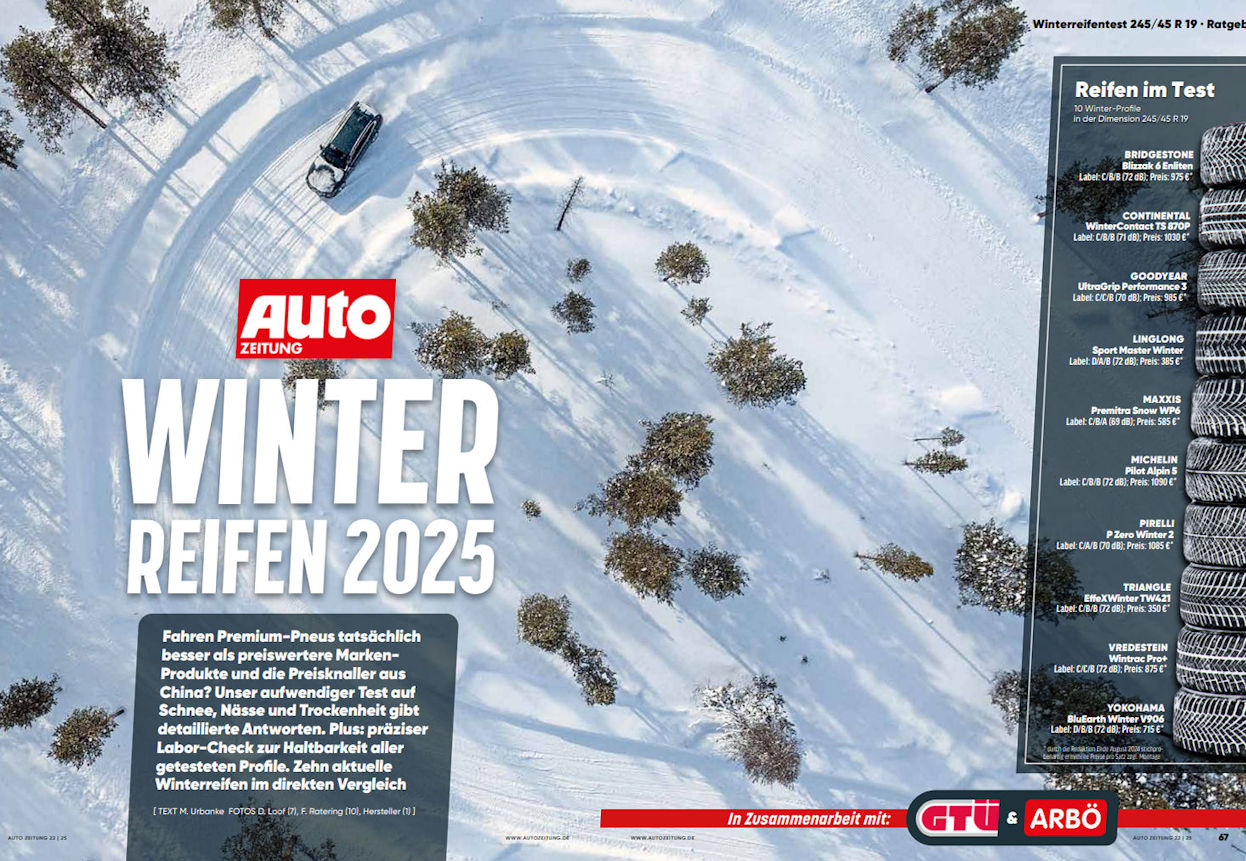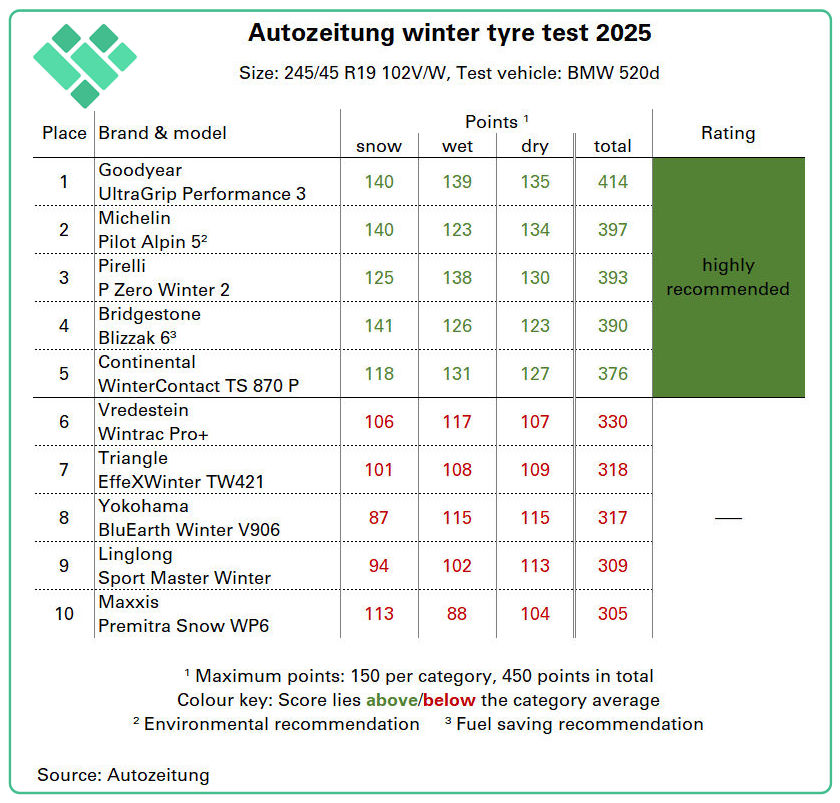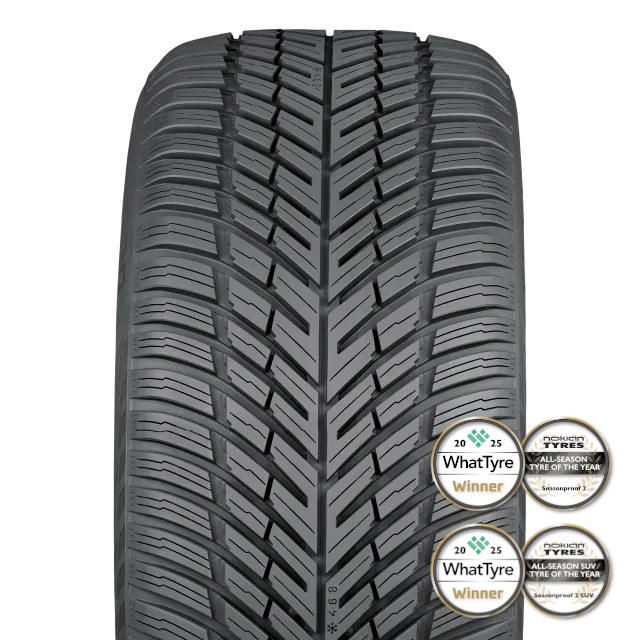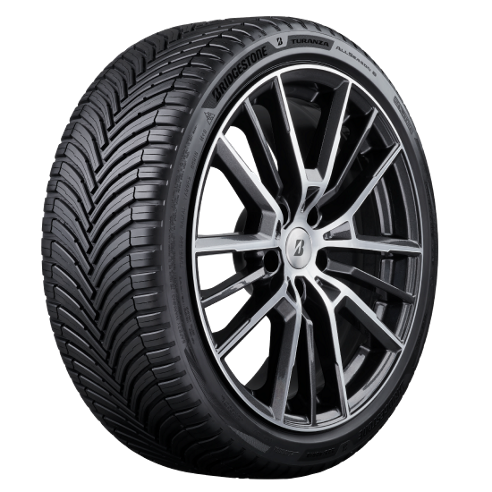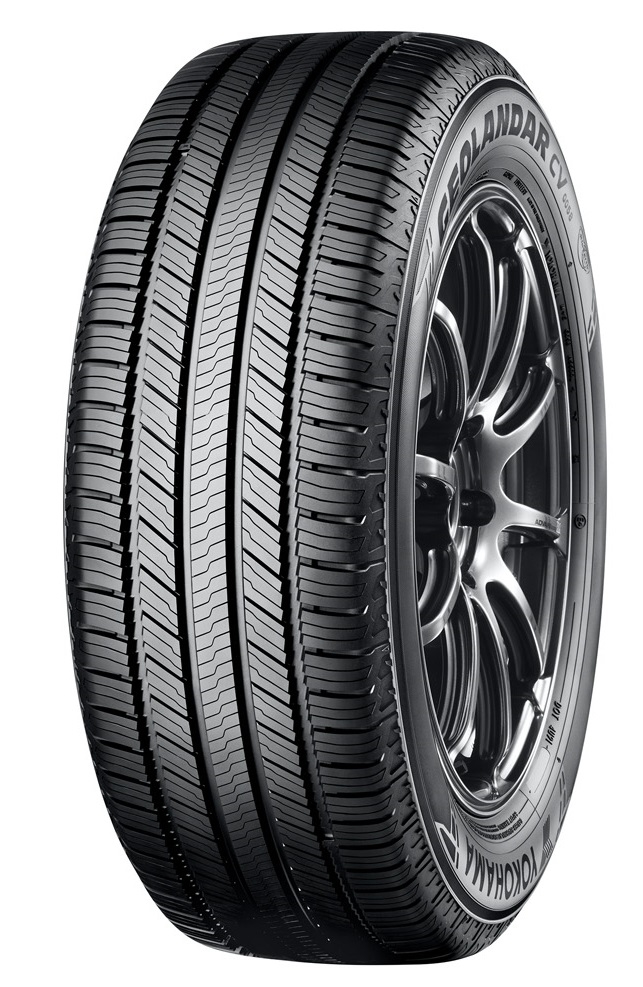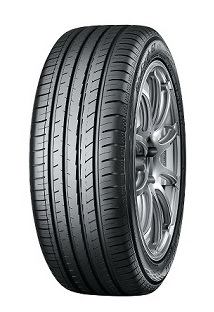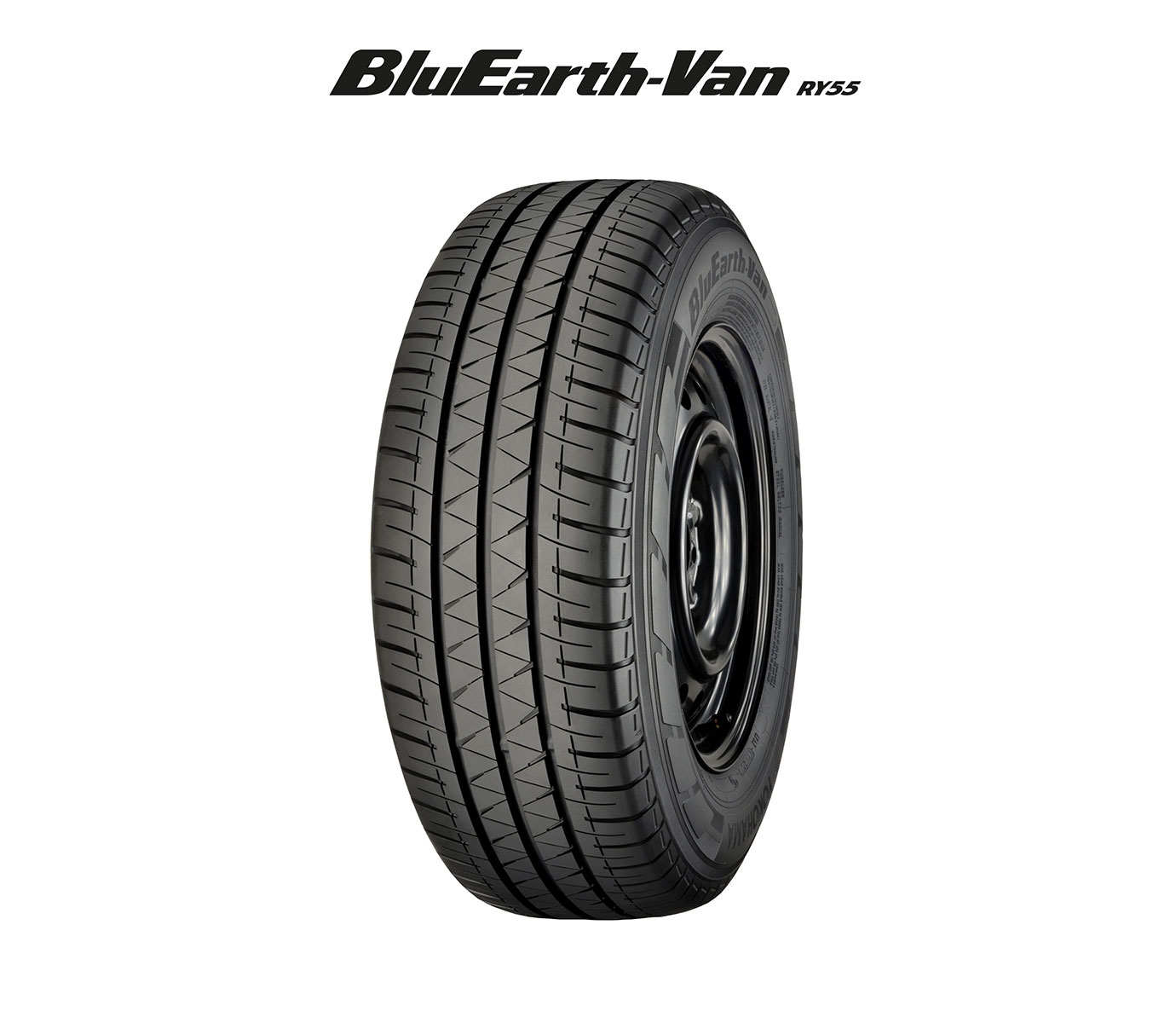Stop teasing us, Autozeitung. Upon reading the opening paragraph of the motoring publication’s 2025 winter tyre test – which questions “Do premium tyres really perform better than cheaper brand-name products and bargain-basement products from China?” – we already knew what the answer would be. We weren’t wrong: The test of ten size 245/45 R19 tyres resulted in five ‘highly recommended’ ratings – all of them awarded to premiums.
To reach this conclusion, Autozeitung fitted all ten tyre brands to a BMW 520d Touring and evaluated each in a range of conditions. The team worked at a Continental proving ground for the wet and dry road components of the test, moving to a Goodyear facility for snow testing. In addition, testbench evaluations were performed at Pirelli and Continental sites, including for mileage potential. Performance in each of the three main weather conditions contribute equally to the final result.
Tester doesn’t rate cheap tyres
“If you are primarily interested in driving economically, cheap tyres are the best option,” comments Autozeitung tester Martin Urbanke. “However, these not only have disadvantages in terms of environmental impact, but also require significant compromises in terms of comfort, performance and safety.”
Ouch. But for Urbanke, these factors can’t simply be traded for money in the bank. He states that in the current test, premium tyres “once again” prove to be highly recommendable, and he considers their higher purchase price “quickly offset” by the increased safety they offer. “The Goodyear UltraGrip Performance 3 mastered the challenges of our test procedure with the greatest aplomb, but the tyres from Michelin, Pirelli, Bridgestone and Continental also performed impressively.”
For reasons Autozeitung doesn’t explain, it only awards one specific rating, highly recommended (sehr empfehlenswert). Tyres that fail to reach this level remain unrated, effectively lumping products that gave a good account of themselves in the same nameless category as tyres which performed poorly.
Rated highly recommended
Test winner: Goodyear UltraGrip Performance 3
“No matter what the surface, the Goodyear Ultra Grip Performance 3 delivers excellent performance at all times and wins this test with ease.”
The Goodyear tyre impresses with its short braking distances, strong traction, and agile yet very safe handling, performing confidently even on snow. It delivers consistently superb results in wet conditions, surpassing even the Pirelli by one point. Quiet, durable, and exceptionally well-balanced, the UltraGrip Performance 3 achieves the highest overall score. It responds with sporty spontaneity while remaining composed and stable at all times – an excellent performance.
Environmental recommendation: Michelin Pilot Alpin 5
“Second place goes to the Michelin Pilot Alpin 5, which performs well in wet conditions and very well in snow and dry conditions. Durable, economical: environmentally recommended.”
The Michelin tyre offers outstanding traction, the best lap times, and very short braking distances, yet falls short of the top spot due to limited feedback and precision. While it delivers solid overall performance, its moderate handling feedback slightly undermines driver confidence. Its excellent durability helps justify the high price, especially as it provides the shortest braking distances. Efficient and comfortable, it is also the most environmentally friendly option.
Pirelli P Zero Winter 2
“The new Pirelli P Zero Winter 2 deserves a clear recommendation thanks to its balanced characteristics. Only its aquaplaning protection when cornering could be improved.”
The Pirelli tyre delivers strong results in traction and braking tests, with decent lateral grip, though it shows an uncharacteristically clear tendency to understeer. It sets the benchmark in wet conditions, offering excellent grip except for a slight weakness in cornering aquaplaning. On dry roads, its performance is flawless, and its well-balanced combination of durability, comfort, efficiency, safety, and driving pleasure is highly impressive.
Fuel saving recommendation: Bridgestone Blizzak 6 Enliten
“The Bridgestone Blizzak 6 Enliten leads the field on snow. With good wet grip and maximum efficiency, it secures fourth place and our recommendation.”
The Bridgestone tyre achieves excellent grip on snow, offering the shortest braking distance, balanced handling, and strong traction – earning top marks in the test. It provides impressive aquaplaning resistance and stable wet-weather performance, responding eagerly to steering inputs. With outstanding results in rolling resistance, slalom performance, and grip levels, the Bridgestone stands out. It features small steering angles and stable support, though its load change reactions are somewhat lively.
Continental WinterContact TS 870P
“The Continental WinterContact TS 870P offers optimum protection against aquaplaning and is easy to control. But braking distances on wet roads could be shorter.”
The Continental tyre handles snowy conditions with ease, though without standing out, offering only moderate traction. On wet roads, it impresses with strong grip and precise feedback, achieving the best result in aquaplaning tests, although its braking distances are relatively long. It provides consistently reliable road holding and secure handling, with clear steering feedback and pleasantly smooth load change responses.
Unrated – the other candidates
Vredestein Wintrac Pro+
“The Vredestein Wintrac Pro+ copes with all weather conditions with solid results. However, its rather long braking distances on wet roads prevent it from achieving a better ranking.”
The Vredestein tyre impresses with its short dry braking distance but fails to stand out in other areas. It is tuned with a tendency to understeer, while its long braking distances limit performance on wet roads. The tyre offers stable handling but suffers from high wear, moderate steering precision, and a predictable yet slightly oversteering behaviour at the limit, costing the comfort-oriented Vredestein valuable points.
Triangle EffeXWinter TW421
“The Triangle EffeXWinter TW 421 is the cheapest tyre but delivers the second-best result in the dry braking test. Poor: durability and handling characteristics.”
“The Triangle tyre offers reliable braking performance but reacts sensitively to load changes and lacks sufficient stability, which undermines driver confidence. Compared with other budget models, it handles impressively well but requires long braking distances. It achieves the second-best result in braking tests and is the quietest on the road, yet falls behind significantly in terms of wear, durability, and stability during load changes.”
Yokohama BluEarth Winter V906
“The Yokohama BluEarth Winter V906 performs quite well on cleared roads but lacks grip on snow – and the tyre lags behind the field.”
The Yokohama tyre provides limited grip on ice and snow, delivering disappointing overall performance, though still maintaining adequate safety margins. On wet roads, it offers predictable handling but only average grip levels. While its braking performance is good, this is offset by moderate results in wear and durability tests, as well as a high rolling resistance. Overall, its grip and precision are decent.
Linglong Sport Master Winter
“The Linglong Sport Master Winter, specially designed for European customers and manufactured in Serbia, is (still) falling short of expectations.”
The Linglong tyre offers only moderate grip on snow, resulting in the longest braking distances – not impressive, though still acceptable. It provides adequate protection against aquaplaning in corners, but its wet braking distances are too long. While it achieves the fastest lap time, its nervous rear axle makes it challenging to handle. The tyre combines short braking distances with high wear, increased rolling resistance, and notable noise levels.
Maxxis Premitra Snow WP6
“The Maxxis Premitra Snow WP6 grips well on snow but is otherwise only moderately competitive. It shows some glaring weaknesses, especially on wet surfaces.”
Among the three budget tyres, the Maxxis delivers the best results on snow, even outperforming two rivals from the quality segment. However, its nervous load change reactions and by far the longest braking distances make it unsuitable for wet conditions. On dry roads, the Maxxis also shows several weaknesses, including the longest braking distance, poor directional stability at the rear axle, and limited durability.

